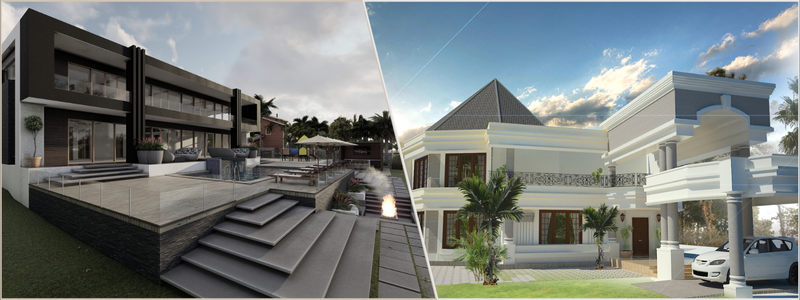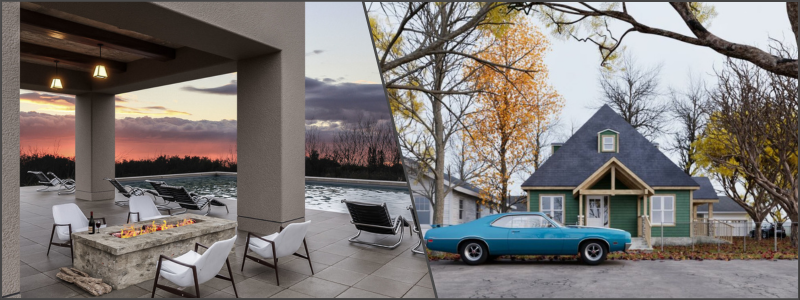3D architectural rendering is a critical tool that generates visual representations of different designs. Thanks to this technology, designers can breathe life into their ideas and present them in a way closest to reality. Setting the right mood is one of the most important aspects of 3D architectural rendering services, which involves the use of the right weather and season.
These factors do significantly affect the overall feel and look of 3D architectural renders. These evoke emotions, propose a unique story, and set the overall mood. For instance, a blue-skied sunny day and lush green grass can create an inviting and cheerful ambiance. On the other hand, dark clouds on a stormy day can depict a sense of despair and gloom. The weather and season also play a critical role in establishing the specific time of day and substantially impact the shadows and lighting in the scene.
Weather and season can also be used to improve the scene’s design features. For instance, if the architectural design showcases a modern house with huge windows and clean lines, a clear sunny day will highlight these features by forming an airy and bright atmosphere. Meanwhile, if the design features a lovely rustic cabin in the middle of the woods, the warm and cozy atmosphere of the area is better emphasized during a snowy winter day.
 Table of contents
Table of contents
- How to choose the right weather and season for 3D architectural renders
- Different types of weather for 3D architectural renders
- Different seasons for 3D architectural renders
- The Bottom Line
- How Cad Crowd can help
RELATED: The benefits of 3D architectural rendering for companies in the real estate industry
How to choose the right weather and season for 3D architectural renders
Several factors must be considered when the architectural 3D architectural visualization expert determines the right weather and season for your 3D architectural renders. Would you like to produce an inviting and cheerful atmosphere or evoke a sense of intrigue and mystery instead? Different types of weather and seasons can help you create various moods. If you will be joining a competition for architectural design, for example, the top secret for persuading the jury is to use a sunny daytime view.
Think of the design features
The scene’s design features are vital in choosing the appropriate weather and season for your 3D architectural render. If a beach house with an outdoor patio and floor-to-ceiling windows is featured in the scene, blue skies during a sunny day and waves lapping on the shore can stimulate a welcoming and relaxing ambiance. If a Gothic castle featuring dark stone walls and towering spires is showcased in the scene, a stormy night with lightning in the background can portray danger and foreboding. However, remember that mood may vary in several situations, so be sure to keep it in mind.
Consider the story
The message or story the scene wishes to convey is another essential factor to consider when deciding on the weather and season the 3D rendering designer will use for your 3D architectural render. For instance, if your scene shows a futuristic city that uses advanced technology and sleek, towering skyscrapers, the easiest way to emphasize the optimistic and bright future represented by the city is to use a sunny day with cloudless blue skies.
But if the scene presents a complete wasteland after the apocalypse with desolate landscapes and remnants of buildings, for example, a stormy day with the skies covered with dark clouds and strong winds might accentuate the dangerous and bleak setting.

Different types of weather for 3D architectural renders
Since you now have an idea about the importance of weather and season in 3D architectural renders, it’s time to learn more about the different types of weather a 3D rendering company can use in your 3D architectural renders:
1. Cloudy
A cloud day features subdued shadows and diffused light to create an even and soft environment. This particular type of weather is recommended for interior architectural renderings since it will cut back the harsh shadows and improve the details. It also represents a contemplative and peaceful mood perfect for wellness or healthcare projects. On the other hand, most exterior architectural views feature a cloudy mood as this helps convey the supremacy of infusing feelings of the object’s power, as in the case of high-rise buildings.
2. Foggy
The 3D visualization service can also use fog to set the atmosphere and mood of 3D architectural renders. Misty landscapes, diffused and soft light, and muted colors represent foggy weather best. The use of cool blue tones combined with a sense of distance helps stimulate a sense of intrigue and mystery. Fog is also one of the ideal options for scenes that highlight enchantment, fantasy, and magic.
3. Rainy
You can use rainy weather to create a sense of atmosphere and mood in 3D architectural rendering projects. Wet surfaces, puddles, and dark, stormy skies are common features that represent rain. The use of moody and dramatic lighting helps produce a sense of suspense and tension. The use of rain is ideal for scenes emphasizing drama, intrigue, and mystery.
4. Snowy
3D architectural renders use a snowy day for holiday or winter-themed scenes. This particular weather features snow-covered surfaces, snowfall, and icicles that create a pristine yet cold atmosphere. Snowy weather also lends a layer of visual interest to the outdoor scenes that highlight the design’s details and create a sense of contrast and depth.
5. Sunny
A sunny day is undoubtedly one of the most common weather conditions used by 3D architectural design experts. A sunny day with bright sunlight and clear blue skies produces a radiant atmosphere. This particular weather is perfect for outdoor architectural renderings that showcase the design’s details in full light. It also produces an optimistic and cheerful mood ideal for promoting your real estate listings and projects.
RELATED: Learn about the types of architectural rendering services available for your company
Different seasons for 3D architectural renders

Aside from the different types of weather, seasons used for 3D architectural rendering projects also vary. These include the following:
1. Fall
The fall season is a time of nostalgia, transformation, and change, making it an excellent option for scenes focusing on sentimentality, transition, and reflection. It is best represented in 3D architectural renders using leaves with changing colors, cool and crisp air, and misty mornings. The 3D architectural modeling professional uses deep, rich colors and warm golden light to help evoke a sense of comfort and coziness. Fall is also the best season to choose if indoor spaces such as kitchens, living rooms, and fireplaces are being showcased.
2. Spring
Being a season of growth and renewal, spring is a great choice for those scenes that focus on new beginnings, optimism, and freshness. Warm and soft light, greenery, and blooming flowers represent the spring season in 3D architectural rendering projects. Using a hazy and soft atmosphere combined with pastel colors can help produce a sense of peacefulness and serenity. Spring is also the best season to highlight outdoor areas like outdoor cafes, parks, and gardens.
3. Summer
Summer is the season of vibrant colors, energy, and warmth, making it the most recommended pick for scenes that accentuate fun, joy, and excitement. Verdant green landscapes, blue waters, and bright sunny skies represent summer in 3D architectural renders. The 3D architectural rendering designer uses warm golden light to evoke a sense of enthusiasm and energy. Summer is also the ideal season to highlight outdoor spaces like backyard barbecues, pools, and beaches.
RELATED: 3D architectural rendering options: in-house, self-learning, or outsourcing services?
4. Winter
Winter is the season of contemplation, reflection, and stillness, making it a favorite choice for those scenes emphasizing quietness, solitude, and introspection. Using cool, muted hues, frosty, snowy landscapes, neutral tones, and diffused soft light can help induce a sense of stillness and calmness. Winter is also the best season for showcasing indoor spaces such as cozy cabins, bedrooms, and libraries.
The Bottom Line
At the end of the day, the specific type of weather and season the architectural visualization expert choose for the 3D architectural renders will always depend on your project and its specific needs, as well as the tone or mood you wish to convey. Ensure that the season and time, the overall context of your design, and the overall aesthetic you wish to achieve are considered before you make your final decision. As long as you choose the appropriate weather and season, designers can come up with 3D architectural renders that are not only visually appealing but are also emotionally impactful and engaging.
How Cad Crowd can help
Do you have a specific mood you want to use for your 3D architectural renders? Do you need clarification on choosing the right weather and season for your project? Don’t hesitate to reach out to the professionals at Cad Crowd, who are certified experts in using the right mood, weather, and season for 3D architectural rendering projects.
With their help, you can look forward to getting the most compelling and realistic 3D architectural renderings that will perfectly embody your projects. Start out with a free quote and


I love how you highlighted the importance of seasonal variations! Seeing a project rendered in various seasons allows architects to consider how natural light and weather impact the design, ensuring a comfortable and inviting space year-round.